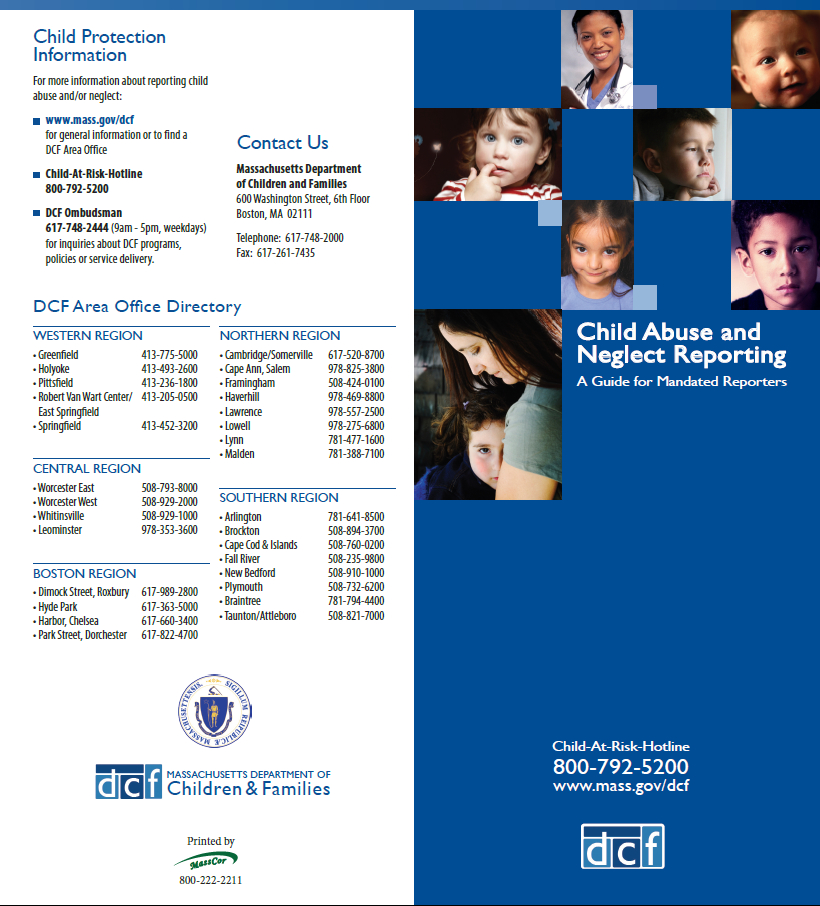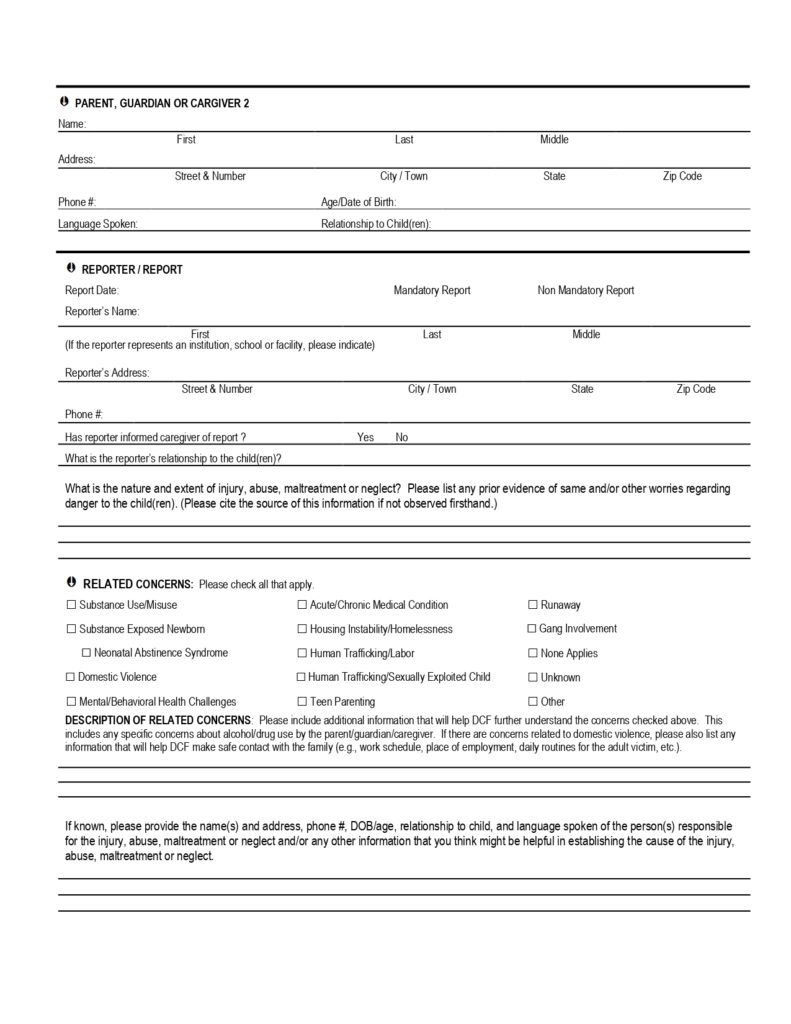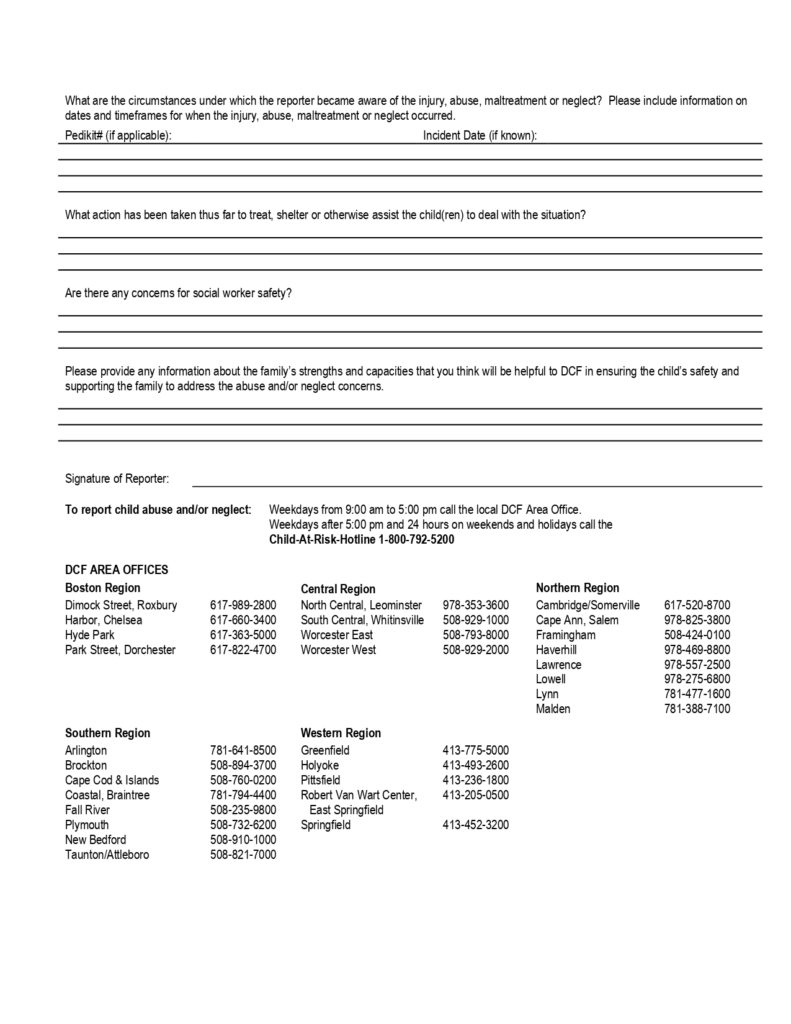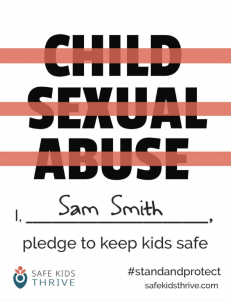Read the Report
Home / Read the Report
Appendix 11: Recognizing, Responding to, and Reporting Allegations and Suspicions
DCF Brochure*

*To see full brochure, click here.
Reporting CHild abuse and negelct (sample 1)
| Massachusetts law: A report must be filed when a mandated reporter has knowledge or reasonable cause to believe that a person under the age of 18 is suffering abuse or neglect. (Name of YSO): Requires all staff, employees and volunteers to contact the designated authority when they have knowledge or reasonable cause to believe that a person under the age of 18 is being, or has been, abused or neglected. Any person may contact or ask to meet with (Name of designee) concerning suspected child abuse by anyone – including managers, supervisors, staff, volunteers, or another child/youth. |
↓
| Reports concerning suspected, observed, or disclosed child abuse must be made to (Name of designee). Contact (Name of designee) by dialing xxxxx from any (Name of organization) Phone or dial direct: Direct Number 1 – (xxx) xxx-xxxx Direct Number 2 – (xxx) xxx-xxxx After Hours Number – (xxx) xxx-xxxx A person who was abused as a child but is now an adult also has the right to file a report with the local District Attorney (DA): Middlesex County DA Suffolk County DA |
↓
| Persons making a report about child abuse to (Name of designee) should be prepared to provide the following information (if known): – the name/address of the child, his parents, or other person responsible for his care; – the child’s age and sex; – the nature and extent of the child’s injuries, abuse, maltreatment, or neglect, including any evidence of prior injuries, abuse, maltreatment, or neglect; – the circumstances under which the reporter first became aware of the above; – whatever action, if any, was taken to treat, shelter, or otherwise assist the child; and – the name of the person or persons making such report. (Name or YSO) will cooperate with civil authorities concerning investigations of a complaint of child abuse and support all investigations with respect for civil law and the rights of individuals. |
↓
| NOTE: Non-mandated reporters can also report suspected abuse anonymously if preferred. |
Reporting child abuse and neglect (sample 2)
| A report must be filed with civil authorities concerning abuse of a child or young person who is now under the age of 18: – Civil law: When a mandated reporter has reasonable cause to believe that a person under the age of 18 is suffering abuse or neglect, they are to report it immediately to the Department of Children and Families (DCF). – The Policy of (name of YSO) requires all staff and volunteers to contact the appropriate civil authorities when that person has knowledge or reasonable cause to suspect that a person under eighteen (18) years of age is being, or has been, abused or neglected. MA Department of Children and Families Local Area Office: (area code) -XXX-XXXX After Hours Emergency: (800) 792-5200 |
| A person who was abused as a child but who is now an adult: – Civil law: The person has the right to file a report with the local District Attorney (DA). Local Area DA: (area code) XXX-XXXX |
⇅
| The Statutes of the State of Massachusetts The report to DCF must be made immediately by telephone and a written report submitted within 48 hours, containing: – the names and addresses of the child and his parents or other person responsible for his care, if known; – the child’s age; the child’s sex; – the nature and extent of the child’s injuries, abuse, maltreatment, or neglect, including any evidence of prior injuries, abuse, maltreatment, or neglect; – the circumstances under which the person required to report first became aware of the child’s injuries, abuse, maltreatment, or neglect; – whatever action, if any, was taken to treat, shelter, or otherwise assist the child; – the name of the person or persons making such report. |
| A report concerning suspected child abuse may also be made to (name of YSO) authorities. Any person may ask to meet with the YSO head or Child Protection Team (CPT) concerning suspected child abuse by anyone – including YSO administrators, staff, or volunteers. Contacts on the YSO Child Protection Team Name/Title Name/Title Business Hours: (area code) XXX-XXXX After Hours: (area code) XXX-XXXX |
↓
| The policy of the (Name of YSO) also requires that all personnel and volunteers communicate: – any complaints received concerning child abuse and neglect; – copies of any report filed with civil authorities concerning child abuse and neglect; to the YSO Child Protection Team or to (Name of YSO designated staff) within 24 hours |
↓
| Policies and Procedures for Child Safety Persons making a complaint about child abuse to the (name of YSO) will normally be asked to provide the following information: – the name of the person against whom the complaint is made, and the name of the complainant; – a detailed description of the alleged abuse, including relevant dates, times, and circumstances; – the names and contact information for persons who may have knowledge of the alleged abuse. The (name of YSO) will cooperate with civil authorities concerning investigations of a complaint of child abuse and support all investigations with respect for civil law and the rights of individuals. |
| NOTE: In the event of imminent danger to a child, (Name of YSO) property, or to (Name of YSO) personnel responsible for the child, call the local (name of city/town/county) Sheriff’s Office or Police Department for help: (area code) XXX-XXXX |
DCF 51A Form



DCF: What Happens When a Report is Made?
The “Protective Intake Policy” framework was designed “to clearly articulate a primary and immediate focus on child safety in screening and responding to reports of child abuse and neglect.” 1
The Protective Intake Policy is divided into two phases: (1) the screening of all reports; and (2) a response to any report that is screened in. As a result, all screened in reports are now investigated.
Specifics about the screening and investigative response are summarized below:
Screening
- Requires non-emergency reports of abuse and neglect to be reviewed and screened in or out in one business day. Emergency reports continue to require an immediate screening decision and an investigatory response within two to four hours
- Screening teams of social workers, supervisors, and managers are charged with reviewing reports of abuse or neglect as defined by the policy. This includes reports of three or more separate incidents in the past 12 months
- Information is gathered about the child and caregiver’s prior DCF involvement, and a review is done of any comparable information available from child welfare agencies in other states, including cases in which a parent has previously lost custody of a child
- Requires CORI (Criminal Offender Record Information), SORI (Sexual Offender Record Information), a DCF history check, and national criminal history database checks of parents/caregivers and all household members over 15 years old
- Requires requests from law enforcement for information on 911 calls and police responses to the residence of any child, youth, or family involved in a report of abuse or neglect
Investigative Response
- All reports that are screened in are assigned to a Response Worker.
- Requires Response Workers to interview parents, caregivers and other children in the home as well as the person allegedly responsible for the abuse or neglect
- Enables Response Workers to search online sources for information relevant to assessing child/youth safety
- Includes an assessment of parental capacity by evaluating whether the parent understands how to keep the child safe, uses appropriate discipline methods and provides for the family’s basic needs, among other criteria
- The Department’s Risk Assessment Tool is used to assess potential future risks to the child’s/youth’s safety.
The Department updated the 51A report form in 2016 to include sections that ask for emergency contact information for the children being reported, whether other children are implicated by the alleged abuse or neglect, and about “related concerns,” including substance abuse and whether DCF social workers should be concerned for their safety when investigating an allegation.
What are the steps DCF takes when it receives a report of child abuse and/or neglect?
When DCF receives a report of abuse and/or neglect or “51A report,” from either a mandated reporter or another concerned citizen, DCF is required to evaluate the allegations and determine the safety of the children/youth. During DCF’s response process, all mandated reporters are required to answer the Department’s questions and provide information to assist in determining whether a child is being abused and/or neglected and in assessing the child’s safety in the household.
Here are the steps in the DCF process:
- The report is screened. The purpose of the screening process is to gather sufficient information to determine whether the allegation meets the Department’s criteria for suspected abuse and/or neglect, whether there is immediate danger to the safety of a child, whether DCF involvement is warranted and how best to respond. The Department begins its screening process immediately upon receipt of a report. During the screening process DCF obtains information from the person filing the report and also contacts professionals involved with the family, such as doctors or teachers who may be able to provide information about the child’s condition. DCF may also contact the family if appropriate.If the report is “Screened-In”, it is assigned for a Response. This response activity includes an investigation of the allegations, assessment of the current dangers and future risks to the child(ren) and an assessment of the capacity of the parent(s)/caregiver to provide safety, permanency and well-being of the child(ren).
The severity of the situation will dictate whether it requires an emergency or non-emergency response.
- A determination is made as to whether there is a basis to the allegation, whether the child can safely remain at home and whether the family would benefit from continued DCF involvement. If DCF involvement continues, a Family Assessment and Action Plan are developed with the family.
Some families come to the attention of the Department outside the 51A process. These include:
Children Requiring Assistance (CRA) cases referred by the Juvenile Court, cases referred by the Probate and Family Court, babies surrendered under the Safe Haven Act, and voluntary requests for services by a parent/family. These cases are generally referred directly for a Comprehensive Assessment.
What are the timeframes for DCF to complete its Screening, Response and/Assessment?
- Screening: Begins immediately for all reports. For an emergency response, the screening is completed within two hours. For a non-emergency response, screening is completed in one working day (with an additional one working day extension in rare circumstances).
- Emergency Investigation: Must begin within two to four hours and be completed within five working days of the receipt of report.
- Non-Emergency Investigation: Must begin within three working days of receipt of report and be completed within 15 working days.
- Comprehensive Assessment: May take up to 45 working days.
What if DCF screens out the report?
If available information is not sufficient for DCF to determine that there is reasonable cause to believe that a child has been abused or neglected, the report will be screened out. As such, it is important that the reporter provide the Department with all the information that might aid DCF in determining whether or not the alleged abuse or neglect occurred. It is wise to have as much information available as possible when calling the Department. However, if the reporter does not have all this information, do not let it impede the filing. File with what information is on hand and let the professionals make their determinations.
Having documentation of relevant facts, dates, quotes, etc., can help to ensure that information is accurately conveyed at the time the report is filed. Documentation can also facilitate the reporter’s recollection of what has gone on with the child/youth over time. However, the decision to file or not file a report should not be based on the fact that the reporter thinks the documentation on hand is insufficient. Remember, mandated reporters are required to report if they have a reasonable cause to believe that a child or youth is suffering abuse or neglect. The suspected abuse or neglect must be immediately reported to the Department by oral communication and by making a written report within 48 hours after the oral communication.
If a report is screened out, it may also be because the alleged perpetrator of the abuse or neglect has been identified, and the individual was not in a caregiver role during the time when the abuse or neglect took place. With the exception of human trafficking allegations, incidents where the alleged perpetrator was not in a caregiver role are beyond DCF’s authority to address. In these situations, DCF may contact and refer the case to the District Attorney and local law enforcement.
Also, if a report is screened out, it does not mean that the reporter cannot file another report at a later date. In the interim, documenting can help in establishing the reporter’s own record of what is going on with the child or youth, and this information can be useful if you decide to file a report in the future. Again, the case that has received several reports, whether screened in or out, can be a source of critical information. In the meantime, help the child or youth by remaining available, acknowledging concerns, helping to enhance self-esteem, and giving the child/youth a positive experience. Staff and volunteers can be an invaluable source of support, and one should not underestimate the influence that they have on children and youth.
What Happens When DCF Receives a 51A Report? 2

From MA DCF, Protective Intake Policy, Revision date: 6/22/20, used with permission.
1 DCF Protective Intake Policy: (https://www.mass.gov/doc/dcf-protective-intake-policy-june-2020/download)
- Acknowledgements
- Executive Summary
- Introduction
- How to Read This Report
- Mission & Purpose of Taskforce
- A Brief History of How the Taskforce Was Organized
- The Charge of the Legislative Language
- Key Sections
- Section 1: Developing Policies and Procedures for Child Protection
- Section 2: Screening and Background Checks for Selecting Employees and Volunteers
- Section 3: Code of Conduct and Monitoring
- Section 4: Ensuring Safe Physical Environments and Safe Technology
- Section 5: Recognizing, Responding to, and Reporting Allegations and Suspicions of Child Sexual Abuse
- Section 6: Training About Child Sexual Abuse Prevention
- Additional Considerations
- Applying the Framework: A Five-Year Plan
- Appendices
- Section-Specific Appendices
- Downloadable Resources

Take the Pledge to Keep Kids Safe
Join us and commit to learning how you can protect the children you serve.
Sign Up to Access Your Learning Center
Customized child sexual abuse prevention guidelines to meet the unique needs of any organization that serves children.
- Evidence-informed guidance
- Actionable prevention steps
- Keeps track of your progress
- Tailored learning tracks


